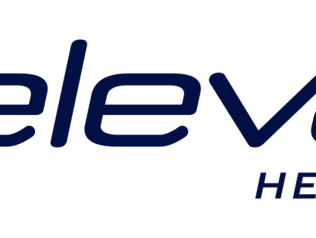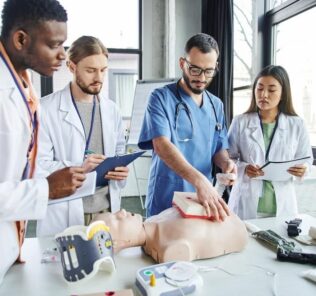Global Healthcare Simulation News Update January 2024
Each month, HealthySimulation.com provides recaps of all the latest healthcare simulation industry news from around the world. This news includes clinical simulation learning opportunities, funding updates, acquisition information, innovation progress, and more. Together, these industry updates help paint a picture of where the global medical simulation industry is presently and where the industry is headed as the scope of clinical simulation practice expands. In this edition for January 2024, you can read about some of the world’s latest clinical simulation updates on the latest technology and partnership announcements, Patient Safety awards, sim training programs, mobile sim training, XR technologies, relevant company acquisitions and launches, patient safety updates, new simulators, sim center openings, and more!
Check out all the recent Healthcare Simulation CE/CME webinars recorded this Month to learn more!
See our IMSH 2024 Coverage: The International Meeting on Simulation in Healthcare (IMSH) is a scientific conference that explores the latest innovations and best practices in healthcare simulation. IMSH provides the tools and resources healthcare professionals need to advance their skills, impact change in delivery systems and practice, and, ultimately, to improve patient safety. View this article to see all the content summaries from the annual meeting!
Master Of Science In Healthcare Simulation Education : The University of Washington’s new online Master of Science in Healthcare Simulation Education degree begins in Autumn 2024. Students will graduate ready to design and deliver high quality, true-to-life clinical learning experiences. Home to both the WWAMI Institute for Simulation in Healthcare (WISH), and the Center for Research in Education and Simulation Technologies (CREST), this degree’s home combines expertise in both the use of simulation in healthcare education — as well as the conception, fabrication, validation and commercialization of the technology.
Sponsored Content:
November Boasts Record-Setting Number of Patient Safety Innovations and Awards : The Patient Safety Technology Challenge announced the winners of the 12 sponsored events that took place since the last week of October, the greatest number of awards for patient safety technology innovation ever in a four-week period. Hack-a-Startup is Carnegie Mellon University Swartz Center of Entrepreneurship’s two-week immersive experience encouraging students to create a start-up on an accelerated timeframe. Teams were incentivized by three general prizes for the best start-up ideas, and a fourth special prize was sponsored by the Patient Safety Technology Challenge to award the best tech-enabled patient safety solution.
NHS Staff Simulation Training Program : The Becoming Simulation Faculty programme supports multi professional educators, practitioners, technicians and managers from higher education institutions and NHS organizations who want to design and deliver simulation and immersive learning. NHSE TEL has been investigating a wide variety of Simulation and Immersive technologies and approaches which will improve healthcare training, whilst also enabling trainees to have a “hands-on” experience. However, these new approaches require new skills for faculty members. The programme is designed support colleagues across healthcare organizations as they explore the basics of teaching with simulation and immersive learning approaches, and to provide a platform on which further local training can be based. After completing the programme, colleagues will have a recognised credential that they can carry with them as they might move from one organization to another.
The future of all-in-one VR is VIVE Ultimate Tracker : Unlock a new dimension of movement and freedom with the first AI-powered self-tracker from HTC VIVE.VIVE Ultimate Tracker 3+1 Kit. Get full-body tracking on VIVE XR Elite and VIVE Focus 3,1 with beta support for other PC VR headsets coming soon. Includes three VIVE Ultimate Trackers and a VIVE Wireless Dongle to let you track your head, hands, waist, and feet.2. Order by January 31, 2024, and receive TrackStraps for VIVE Ultimate Tracker + Dance Dash Game Key.3. VIVE Ultimate Tracker seamlessly delivers every punch, twist, and shake straight into virtual reality2 — great for any activity.
INTRODUCING: SynDaver Modular Canine : The SynDaver Modular Canine offers a veterinary solution that is fully customizable to fit your program needs. Choose from multiple configurations to easily swap out limbs, abdominal, and airway management setups. Compatible with SynTissue Surgical Canine Abdominal Organs.This fully silicone model maintains the realism of our other SynDaver products that you already know and love, but eliminates the need for additional storage requirements. Build to suit, plug and play, the perfect addition to fill the gap in your program.
Sponsored Content:
Exploring virtual reality in teaching and learning : New technology provides space for collaboration, situational learning.DECEMBER 5, 2023 -The College of Nursing in the Rady Faculty of Health Sciences is a leader in simulation education among nursing faculties across the country. Now, they are extending their simulations with virtual reality. Nicole Harder, associate professor in nursing and the Mindermar Professor in Human Simulation for the Rady Faculty of Health Sciences, says one of the newer opportunities in simulation education is virtual reality, which provides opportunities to teach things like prioritization, problem solving and clinical decision-making skills.
Virtual reality surgery puts North Shore Community College students in simulated operating rooms : DANVERS – The future of education is here at North Shore Community College where surgical technology students are using virtual reality to learn procedures in simulated operating rooms.”It’s game changing for these students. They’re so much more prepared to go to clinical,” program coordinator, Jennifer Forte told WBZ-TV. She said there’s a nationwide critical shortage of surgical technologists and this enhances their program to get more students into the field.Students use VR headsets to see into operating rooms where they can practice identifying surgical instruments, passing them to a surgeon and learning steps to several procedures using videos of real surgeries. “You can hear it talking to you. It’s asking you what to do. I’ve only done that procedure that we’re doing today two or three times, and I can already anticipate what’s going on,” student Alexa Jaynes told WBZ.
Virtual reality ‘gaming’ used to plan delicate cancer surgeries : Ontario teenager Emeric Leblanc has become one of the first patients in Canada to undergo surgery for a rare bone cancer using a newly developed virtual reality (VR) system. The tech—modeled after video games is designed by Ottawa-based startup Realize Medical, and it allows surgeons to navigate a simulation of a patient’s body in a virtual space, in an effort to plan complex surgeries. According to coverage from CTV News, Leblanc was diagnosed with Ewing sarcoma, and previously underwent chemotherapy and radiation. It was then that the surgical team at the Ottawa Hospital Cancer Program used the VR system to visualize and plan the removal of a 12-centimeter tumor engulfing much of his left hip bone.
The Impact of Simulation-Based Training in Cardiovascular Medicine: A Systematic Review : Cardiovascular medicine and practice in recent times have evolved as complex procedures are performed to manage difficult cases. The majority of these interventions are done percutaneously in order to minimize patient risk. Additionally, training specialist in handling these interventions require a lot of exposure to them; as such, patients are at higher risk of errors and complications from trainees before attaining expertise. In order to avoid these possible risks to patients and ensure their safety, using simulation commonly in cardiovascular specialist education is a possible trend in the future. This article aims to review randomized controlled trials that were performed in cardiology and vascular medicine regarding the use of simulating models to transfer skills to trainees.
Development of a low-cost congenital abdominal wall defect simulator (wall-go) for undergraduate medical education: a validation study : Congenital Anomalies were responsible for 303,000 deaths in the neonatal period, according to the WHO, they are among the world’s top 20 causes of morbidity and mortality. Expensive simulators demonstrate several diseases, but few are related to congenital anomalies. This study aims to develop, validate, and evaluate low-cost simulator models (WALL-GO) of the most common abdominal wall defects, gastroschisis, and omphalocele, to enable diagnosis through an accessible tool with study value and amenable to replication.
Effectiveness of simulation-based cesarean section education on improving non-physician clinician midwife’s competency in performing cesarean section in Ethiopia: a quasi-experimental study : Simulation-based education enhances fundamental and clinical knowledge, procedural abilities, teamwork, and communication skills, as well as quality of care and patient safety. Due to excessive clinical loads and a lack of physicians, even classic teaching methods like bedside instruction are constrained in low-income settings. Thus, this study aimed to ascertain if simulation-based cesarean section education successfully raises non-physician clinician midwives’ competency in Ethiopia.
Virtual reality laparoscopic simulation for operating theatre efficiency: an outcome logic model program evaluation : Operating theatre time is a costly resource, requiring efficient but safe surgical proceduralists. Training on laparoscopic simulators has potential to improve surgeons’ efficiency, but the translation of these benefits to clinical outcomes is often not realized [1]. This article describes introduction of a comprehensive laparoscopic simulation education program aiming to enhance operative efficiency in gynaecological procedures at a tertiary health service. We describe our approach to educational design, clinical integration and evaluation using an outcome logic model.
‘How can we ensure that simulated learning is taught effectively?’ : During the Covid-19 pandemic, emergency standards were introduced by the Nursing and Midwifery Council (NMC) to allow education institutions to deliver a proportion of their practice learning through simulation.This has now been made a permanent standard by the NMC, allowing up to 600 hours (about three and a half weeks) of simulated practice learning within the required 2,300 practice learning hours required for students to complete their nursing training.Alongside this new standard, a new definition for simulation was created, which describes simulated learning as an educational method using a variety of modalities to support students to develop their knowledge, behavior and skills.
In loving memory of Denzil Miller: a Sawbones founder & innovator in orthopedics. With heavy hearts, we announce his passing. Denzil’s visionary contributions leave an indelible mark on Sawbones. Our deepest condolences to his family. Share your memories of his remarkable life.280 characters does not do this man justice. There aren’t enough words to describe what he meant to Sawbones or the orthopedic community. Truly a legend.
SG24USA Call for Abstracts : The SimGHOSTS 2024 USA Conference (SG24USA) is set to take place in Indianapolis, Indiana from August 6-9. Hosted by IU Health, IU School of Medicine, and IU School of Nursing, this 3.5 day event at the Simulation Center at Fairbanks Hall is designed to Accelerate Your Success in Healthcare Simulation. By focusing on the latest insights in simulation technology and providing practical advice, tips, tricks, and hacks, SG24USA is the premier platform to stay ahead of the trends and technologies that will fast track your healthcare simulation career. Don’t miss this transformative opportunity to enhance your CV and your simulation technology and operations knowledge by presenting at the leading healthcare simulation operations and technology conference. Submit your abstract today. We double dare you!
‘Distress!’ wins Gold Medal in Serious Play Awards : Grendel Games has received the highest international distinction at the prestigious International Serious Play Awards ’23 in Toronto. This event is a leading international gathering for game developers creating serious games to enhance skills and knowledge development.We were awarded the gold Serious Play Award for our serious game ‘Distress!’. This app is designed to train nurses in recognizing subtle signs of respiratory problems in patients and responding appropriately. Early identification of breathing issues and timely intervention contribute to a reduction in the number of cardiac arrests among hospital patients. The game was developed in collaboration with medical professionals from the University of Maryland in Baltimore Eric B. Bauman.
A simple guide to the Patient Safety Incident Response Framework (PSIRF) : From Autumn 2023, NHS organizations in England are changing the way they investigate patient safety incidents. NHS England has introduced this new approach, which is called the Patient Safety Incident Response Framework (PSIRF).NHS England has produced detailed resources for patient safety leaders and policy makers about the purpose of PSIRF and what organizations are expected to do to deliver this part of the NHS Patient Safety Strategy. However, discussions with frontline clinicians, patient safety managers, educators and Patient Safety Partners have highlighted the need for a simple guide that helps communicate PSIRF to a wide range of stakeholders, including those who do not work in healthcare.
EMS at I/ITSEC 2023: As EMS continues our evolution and moving forward in the simulation and training environment,we’re really excited to be here at ICC.Introducing the next generation and mobile healthcare solution.Our goal,as it has been from the beginning,is to continuously provide our partner more effective,more efficient and more configurable technology solutions to meet the needs that they have today and tomorrow.So one of the things I’m excited about is our training in motion solution.This really is an upgrade to our systems.We have mobile systems,portable systems,and static systems and we put all those together to have one product that you can take anywhere,do the training,and again,follow along with the training.
https://www.youtube.com/watch?v=DsgmCDoO19Q&vq=hd1080
CPR Quality Officer role to improve CPR quality: A multi-centred international simulation randomised control trial : An out-of-hospital cardiac arrest requires early recognition, prompt and quality clinical interventions, and coordination between different clinicians to improve outcomes. Clinical team leaders and clinical teams have high levels of cognitive burden. We aimed to investigate the effect of a dedicated Cardio-Pulmonary Resuscitation (CPR) Quality Officer role on team performance.This multi-centre randomized control trial used simulation in universities from the UK, Poland, and Norway. Student Paramedics participated in out-of-hospital cardiac arrest scenarios before randomisation to either traditional roles or assigning one member as the CPR Quality Officer. The quality of CPR was measured using QCPR and Advanced Life Support (ALS) elements were evaluated.
Virtual simulation in healthcare education: a multi-professional, pan-Canadian evaluation : As we experience a shortage of healthcare providers in Canada, it has become increasingly challenging for healthcare educators to secure quality clinical placements. We evaluated the impact of virtual simulations created for the virtual work-integrated learning (Virtu-WIL) program, a pan-Canadian project designed to develop, test, and offer virtual simulations to enrich healthcare clinical education in Canada. Evaluation was important since the virtual simulations are freely available through creative commons licensing, to the global healthcare community.Students self-reported their experiences with the virtual simulations and the impact on their readiness for practice using a survey that included validated subscales. Open-ended items were included to provide insight into the students’ experiences.
Medical Improv has updated their resource website where healthcare simulation educators can find lots of videos, interviews, and articles about how this teaching tool can help in healthcare simulation.
GigXR and CAE Healthcare (currently know as Elevate Healthcare) Form Strategic Alliance to Enhance Training Efficiencies with Multimodal Simulation
- Shared vision for multimodal simulation spans analog, immersive and digital techniques
- Multimodal delivery meets diverse healthcare learning environments and needs
- GigXR and CAE Healthcare, now known as Elevate Healthcare to showcase partnership potential at IMSH 2024
GigXR, Inc., a global provider of extended reality (XR) solutions for healthcare training, and CAE Healthcare, now known as Elevate Healthcare announced today their partnership to enhance the efficiency and effectiveness of clinical simulation. The collaboration between GigXR and CAE Healthcare streamlines the ability to implement and manage multimodal simulation for medical schools, nursing schools, hospital systems, first responders, and government – spanning analog, immersive and digital modalities that can be used to create full curricula. Read the full press release here.
“We see the future of simulation as multimodal, encompassing physical, digital, virtual and immersive products that leverage emerging technologies like Generative AI to provide comprehensive solutions for learning efficiency,” said Jeff Evans, President of CAE Healthcare (Elevate Healthcare). “As we work to implement this vision we are balancing investments in CAE Healthcare products while also looking at best of breed players in the market that we should partner with to accelerate this transition. By partnering with GigXR, we are enabling a core part of this vision through “simulation everywhere” to make training and education more accessible and efficient to ultimately improve learning and patient safety.”
“GigXR’s immersive learning platform already unifies immersive and digital training applications into one system, allowing customers to manage a full curriculum’s worth of digital and immersive experiences from a single dashboard,” said Jared Mermey, CEO of GigXR. “Our platform is designed to be further interoperable with partners like CAE Healthcare, now Elevate Healthcare including both their digital and analog capabilities. The results will be a holistic approach to simulation that combines analog and digital – and the right simulation technique to be used at the appropriate time whether inside or outside of the sim center.”
Virtual Medical Coaching’s All-Inclusive Web Portal: The introduction of Virtual Medical Coaching’s WebPortal signifies a giant leap forward in the realm of XR learning. This all-inclusive platform serves as a one-stop destination, seamlessly integrating VR and Desktop simulation software for medical coaching. The portal provides a holistic experience, from launching simulations to receiving detailed feedback, allowing users to tailor their learning experience according to their preferences.
Sony Reveals Standalone MR Headset with “4K” OLED Displays and Unique Controllers: Today at CES Sony revealed a new standalone MR headset equipped with “4K” OLED displays. The headset is yet-unnamed, but the company says it’s aimed at creatives building 3D content and will launch this year. Sony’s unnamed standalone MR headset is based on Qualcomm’s XR2+ Gen 2 processor and is said to include 1.3-inch “4K” OLED microdisplays. It isn’t clear at this time if Sony means 16MP (4,000 × 4,000) per-eye, or something else, but considering that XR2+ Gen 2 can purportedly power two displays up to 18.5MP (4,100 × 4,100) each, it may indeed be the case. We’ve reached out to the company for clarity.
Oxford Medical Simulation: VR Healthcare Training Company Raises $12.6 Million: Oxford Medical Simulation (OMS) – a pioneer in VR healthcare training – announced the successful completion of a $12.6 million Series A funding round. The funding round, led by Frog Capital with follow-on capital from ACF Investors, existing shareholders, and strategic partners, marks a significant milestone in OMS’ mission to revolutionize healthcare education, training, and assessment.
Laerdal and SIMCharacters Announce Exclusive Worldwide Distribution Partnership for SIMCharacters Innovative Neonatal Simulation Solutions: Laerdal Medical, a global leader in healthcare simulation solutions, is excited to unveil its exclusive worldwide distribution partnership with SIMCharacters, a pioneering Austrian company specializing in cutting-edge neonatal simulation technology. This strategic partnership marks a significant milestone in advancing healthcare simulation and underscores a shared commitment to revolutionizing medical training. SIMCharacters made waves in 2018 with the launch of “Paul,” an advanced premature simulator that garnered acclaim for its high-emotion simulation capabilities. Building on their success, SIMCharacters is set to unveil their highly anticipated second product, “Emily,” a full-term simulator, at IMSH 2024.
New Center Aims to Improve Simulation Learning: Simulation education in the health professions is widely used at colleges and medical facilities across the globe. While educators have implemented it in various ways, what’s been missing is research that can rigorously test and compare accepted practices and identify and develop more effective simulation learning experiences. That’s about to change. The MGH Institute’s new Center of Excellence on Healthcare Simulation Research has been created to advance the field of simulation-based educational scholarship.
Center of Excellence in Healthcare Simulation Research: Our mission is innovating traditional educational techniques toward the highest possible learning outcomes through the study of effectiveness of experiential teaching methods. We lead simulationists on how to best conduct healthcare simulation research and our research informs simulationists on the most effective educational approaches. The Center generates novel insights around simulators and academic experiential teaching methods, while also offering valuable guidelines for optimizing simulation practices. This Center delves into the fundamental principles of learning, studying the cognitive neuroscience and biometric findings that occur when using widely accepted teaching and learning methodologies.
CAE Healthcare and SimHawk Form Strategic Alliance to Enhance Training Efficiencies with Multimodal Simulation in Ultrasound: CAE Healthcare( Elevate Healthcare), a global leader in healthcare simulation solutions, recently announced their partnership with SimHawk to enhance the efficiency and effectiveness of ultrasound education. This collaboration will optimize and streamline ultrasound learning by pairing SimHawk’s didactic and motion-based applied learning and CAE Healthcare’s manikin-based simulation offered through the CAE Vimedix product line. “We continue to identify best-of-breed organizations to partner with in delivering multimodal simulation solutions that encompass physical, digital, virtual and immersive products, so we are delighted to add SimHawk to our portfolio of offerings for ultrasound training and education,” said Jeff Evans, President, CAE Healthcare. “By partnering with SimHawk, we are augmenting our established Vimedix platform that makes training and education more accessible and efficient, and we are enhancing our role as a leader in ultrasound simulation.”
Disney offers an elegant solution to VR’s movement problem: Remember the Virtuix Omni? I’ll never forget trying out an early version of the virtual reality treadmill in a hotel suite many E3s ago. The system, which features a concave platform and slippery shoes, was clever enough to influence Ready Player One’s take on the space. The electronics-free system finally started shipping earlier this year. One thing you can say about VR is that it’s inspiring a lot of creative solutions to different issues around the tech. Movement is a major one, of course. You lose some of that visceral sensation when your FPV avatar is cruising around while you’re just sitting there on the couch. For the foreseeable future, however, all solutions will have some key drawbacks. Price is one in Omni’s case, and likely will be for a lion’s share of these sorts of peripherals. Other issues are size (it’s huge) and sound (it’s very noisy).
Revolutionizing Healthcare Training with VR: A Student-Centric Approach: Blog post delving into the transformative impact of VR simulations on healthcare training, highlighting a student-focused paradigm shift in education. In the dynamic landscape of healthcare education, Virtual Reality (VR) simulations not only bring forth immersive learning experiences but also introduce a unique shift in focus—from patient-centric to student-centric training. In traditional clinical environments, supervisors rightfully prioritize patient care. However, within VR simulations, the spotlight is unequivocally on the students, fostering an unparalleled level of individualized attention and guidance.
Patient Safety Technology Challenge: The Patient Safety Technology Challenge is designed to fuel the engagement of students and innovators in creating solutions and envisioning transformational approaches to reduce preventable harm from medical errors. The initiative injects PATIENT SAFETY AWARDS into existing local, regional, and national competitions to support budding tech-enabled patient safety solutions and is in production of a documentary to help increase awareness of the patient safety crisis. Guided by national partners experienced in safety technology and advanced healthcare analytics, the Challenge funds awards to organizers of existing events, from hackathons to start-up weekends.
Labia Repair Model Perineal Assessment and Suturing Trainer: The Labia Repair Model is a training tool designed for midwives, nursing, medical, and health clinicians to learn and practice perineal assessment and suturing. Repetitive and realistic practice of these important midwifery and obstetrics skills are vital to ensure a positive impact on a patient’s quality of life. In partnership with GynZone and Vulva Enterprise, the Labia Repair model, in a safe and dry environment, facilitates: Instrument handling skills and practice Suturing technique Knot-tying methods
Sign Up for Our Free Newsletter to Stay Informed!
Lance Baily, BA, EMT-B, is the Founder / CEO of HealthySimulation.com, which he started in 2010 while serving as the Director of the Nevada System of Higher Education’s Clinical Simulation Center of Las Vegas. Lance also founded SimGHOSTS.org, the world’s only non-profit organization dedicated to supporting professionals operating healthcare simulation technologies. His co-edited Book: “Comprehensive Healthcare Simulation: Operations, Technology, and Innovative Practice” is cited as a key source for professional certification in the industry. Lance’s background also includes serving as a Simulation Technology Specialist for the LA Community College District, EMS fire fighting, Hollywood movie production, rescue diving, and global travel. He and his wife live with their two brilliant daughters and one crazy dachshund in Las Vegas, Nevada.
Sponsored Content:






















